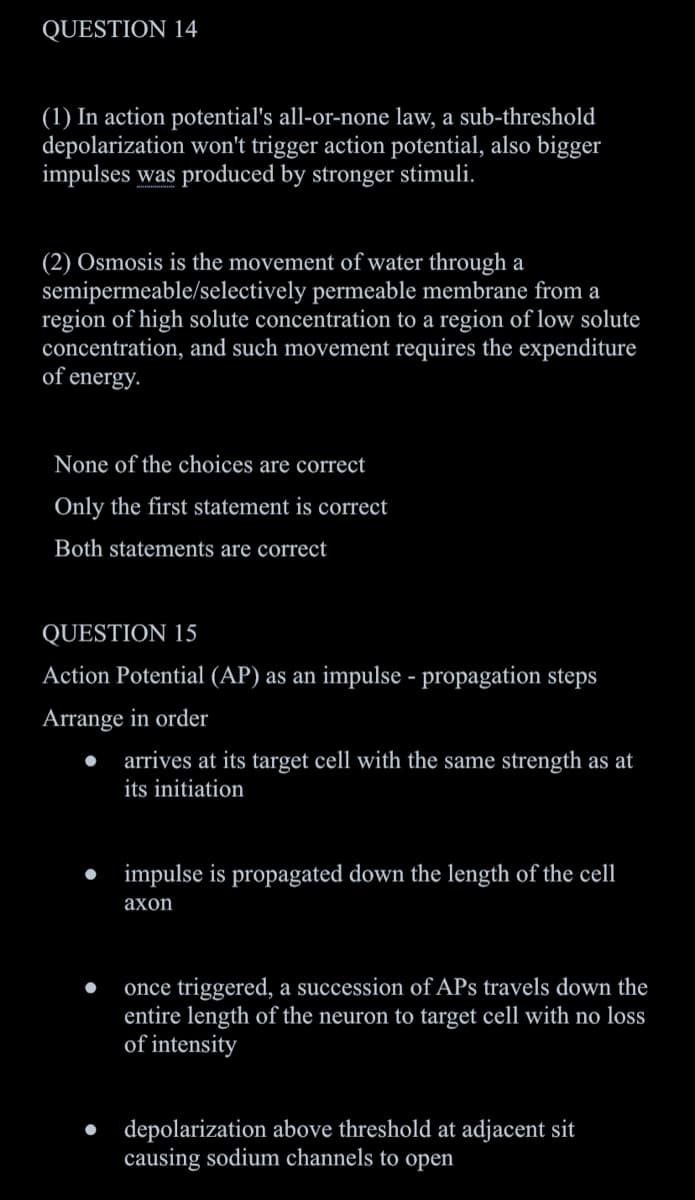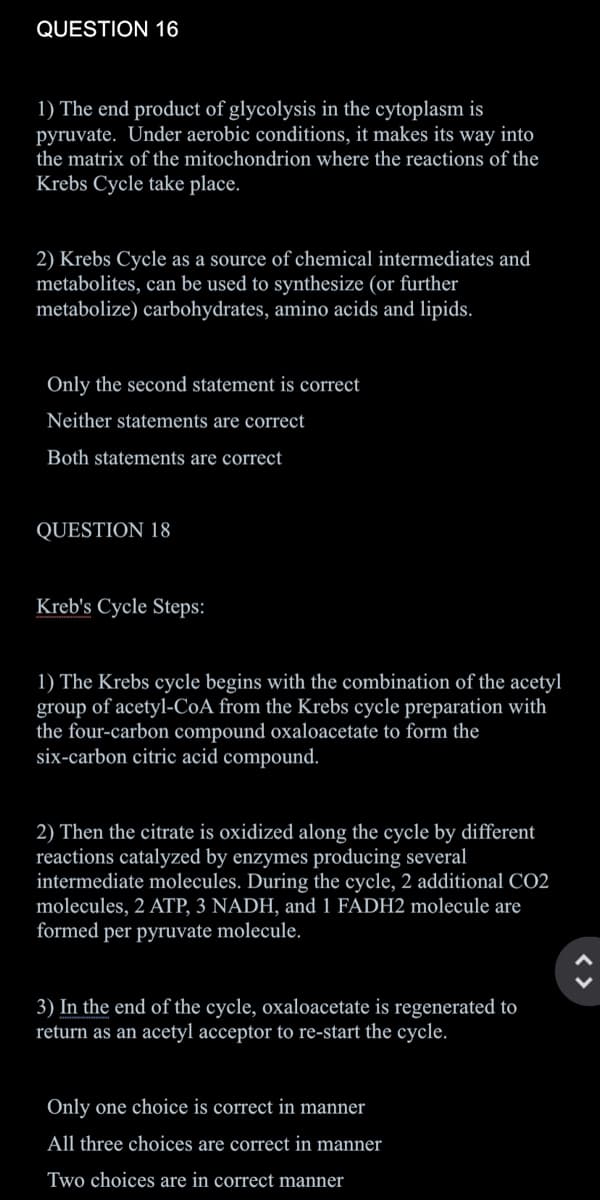QUESTION 14 (1) In action potential's all-or-none law, a sub-threshold depolarization won't trigger action potential, also bigger impulses was produced by stronger stimuli. (2) Osmosis is the movement of water through a semipermeable/selectively permeable membrane from a region of high solute concentration to a region of low solute concentration, and such movement requires the expenditure of energy. None of the choices are correct Only the first statement is correct Both statements are correct QUESTION 15 Action Potential (AP) as an impulse - propagation steps Arrange in order • arrives at its target cell with the same strength as at its initiation • impulse is propagated down the length of the cell ахоn once triggered, a succession of APs travels down the entire length of the neuron to target cell with no loss of intensity depolarization above threshold at adjacent sit causing sodium channels to open
QUESTION 14 (1) In action potential's all-or-none law, a sub-threshold depolarization won't trigger action potential, also bigger impulses was produced by stronger stimuli. (2) Osmosis is the movement of water through a semipermeable/selectively permeable membrane from a region of high solute concentration to a region of low solute concentration, and such movement requires the expenditure of energy. None of the choices are correct Only the first statement is correct Both statements are correct QUESTION 15 Action Potential (AP) as an impulse - propagation steps Arrange in order • arrives at its target cell with the same strength as at its initiation • impulse is propagated down the length of the cell ахоn once triggered, a succession of APs travels down the entire length of the neuron to target cell with no loss of intensity depolarization above threshold at adjacent sit causing sodium channels to open
Human Anatomy & Physiology (11th Edition)
11th Edition
ISBN:9780134580999
Author:Elaine N. Marieb, Katja N. Hoehn
Publisher:Elaine N. Marieb, Katja N. Hoehn
Chapter1: The Human Body: An Orientation
Section: Chapter Questions
Problem 1RQ: The correct sequence of levels forming the structural hierarchy is A. (a) organ, organ system,...
Related questions
Question
CHOOSE THE CORRECT ANSWERS IN THE FOLLOWING QUESTIONS

Transcribed Image Text:QUESTION 14
(1) In action potential's all-or-none law, a sub-threshold
depolarization won't trigger action potential, also bigger
impulses was produced by stronger stimuli.
(2) Osmosis is the movement of water through a
semipermeable/selectively permeable membrane from a
region of high solute concentration to a region of low solute
concentration, and such movement requires the expenditure
of energy.
None of the choices are correct
Only the first statement is correct
Both statements are correct
QUESTION 15
Action Potential (AP) as an impulse - propagation steps
Arrange in order
arrives at its target cell with the same strength as at
its initiation
• impulse is propagated down the length of the cell
ахоn
once triggered, a succession of APs travels down the
entire length of the neuron to target cell with no loss
of intensity
• depolarization above threshold at adjacent sit
causing sodium channels to open

Transcribed Image Text:QUESTION 16
1) The end product of glycolysis in the cytoplasm is
pyruvate. Under aerobic conditions, it makes its way into
the matrix of the mitochondrion where the reactions of the
Krebs Cycle take place.
2) Krebs Cycle as a source of chemical intermediates and
metabolites, can be used to synthesize (or further
metabolize) carbohydrates, amino acids and lipids.
Only the second statement is correct
Neither statements are correct
Both statements are correct
QUESTION 18
Kreb's Cycle Steps:
1) The Krebs cycle begins with the combination of the acetyl
group of acetyl-CoA from the Krebs cycle preparation with
the four-carbon compound oxaloacetate to form the
six-carbon citric acid compound.
2) Then the citrate is oxidized along the cycle by different
reactions catalyzed by enzymes producing several
intermediate molecules. During the cycle, 2 additional CO2
molecules, 2 ATP, 3 NADH, and 1 FADH2 molecule are
formed per pyruvate molecule.
3) In the end of the cycle, oxaloacetate is regenerated to
return as an acetyl acceptor to re-start the cycle.
Only one choice is correct in manner
All three choices are correct in manner
Two choices are in correct manner
Expert Solution
This question has been solved!
Explore an expertly crafted, step-by-step solution for a thorough understanding of key concepts.
Step by step
Solved in 2 steps

Knowledge Booster
Learn more about
Need a deep-dive on the concept behind this application? Look no further. Learn more about this topic, biology and related others by exploring similar questions and additional content below.Recommended textbooks for you

Human Anatomy & Physiology (11th Edition)
Biology
ISBN:
9780134580999
Author:
Elaine N. Marieb, Katja N. Hoehn
Publisher:
PEARSON

Biology 2e
Biology
ISBN:
9781947172517
Author:
Matthew Douglas, Jung Choi, Mary Ann Clark
Publisher:
OpenStax

Anatomy & Physiology
Biology
ISBN:
9781259398629
Author:
McKinley, Michael P., O'loughlin, Valerie Dean, Bidle, Theresa Stouter
Publisher:
Mcgraw Hill Education,

Human Anatomy & Physiology (11th Edition)
Biology
ISBN:
9780134580999
Author:
Elaine N. Marieb, Katja N. Hoehn
Publisher:
PEARSON

Biology 2e
Biology
ISBN:
9781947172517
Author:
Matthew Douglas, Jung Choi, Mary Ann Clark
Publisher:
OpenStax

Anatomy & Physiology
Biology
ISBN:
9781259398629
Author:
McKinley, Michael P., O'loughlin, Valerie Dean, Bidle, Theresa Stouter
Publisher:
Mcgraw Hill Education,

Molecular Biology of the Cell (Sixth Edition)
Biology
ISBN:
9780815344322
Author:
Bruce Alberts, Alexander D. Johnson, Julian Lewis, David Morgan, Martin Raff, Keith Roberts, Peter Walter
Publisher:
W. W. Norton & Company

Laboratory Manual For Human Anatomy & Physiology
Biology
ISBN:
9781260159363
Author:
Martin, Terry R., Prentice-craver, Cynthia
Publisher:
McGraw-Hill Publishing Co.

Inquiry Into Life (16th Edition)
Biology
ISBN:
9781260231700
Author:
Sylvia S. Mader, Michael Windelspecht
Publisher:
McGraw Hill Education